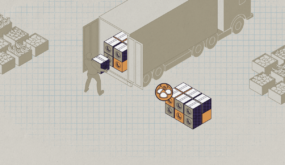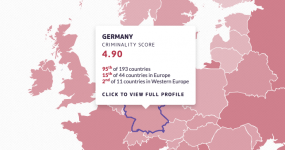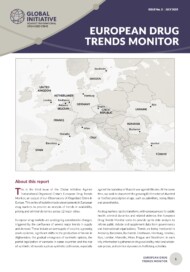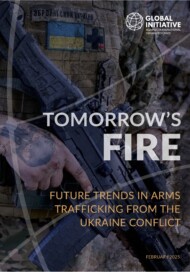In early July 2024, in a rented, empty warehouse in Germany, a local drug dealer recorded himself showing off his stash of half a tonne of cannabis during a livestream, broadcasting his haul – entrusted to him by a Dutch criminal network – to an online audience. Later that night, while the dealer was out partying, 300 kilograms of that cannabis disappeared, allegedly stolen by one of his online viewers.
The cannabis theft unleashed an unprecedented wave of violence in Germany’s North Rhine-Westphalia region, attributed to the so-called ‘Mocro’ mafia – an infamous criminal ecosystem most commonly associated with the Netherlands. Since then, at least six makeshift explosive devices have been detonated across the region, with one incident resulting in the death of a 17-year old Dutch national in a failed attempt to blow up a restaurant. The fallout from the stolen cannabis has also led to the kidnapping and torture of a member of another major criminal network, and the Dutch criminals have offered a substantial bounty for the thieves. A Bonn police officer was detained on suspicion of working with the Dutch criminal network behind these attacks.
The German public could hardly believe that all these incidents happened in the space of just a few weeks. Until recently, Germans viewed organized crime developments in neighbouring countries – shoot-outs, targeted killings of journalists and witnesses, the violent liberation of prisoners and hundreds of explosive attacks – with distant astonishment. Despite Germany’s proximity to countries affected by escalating violence, such as the Netherlands, Belgium and France, such levels of criminality seemed a remote problem. However, in 2023, the Global Organized Crime Index had pointed to rising levels of criminality and declining resilience in Germany, a trend that now arguably appears to have been confirmed by incidents such as these.
Although a massive increase in cocaine seizures, the infiltration of port infrastructure and high-level art thefts have lately raised alarm bells in Germany, violent incidents have tended to be isolated and limited in scope. However, recent developments suggest that the country is not immune to the spillover effects of escalating criminal dynamics.
The ‘Mocro’ mafia
Germany’s illicit drug market is highly diversified and competitive. Criminal ecosystems in major German cities are dominated by a mix of networks – German, Russian-Eurasian, Turkish, Balkan, Arab, Kurdish and Italian, to name a few. These groups control different segments of the retail and wholesale markets, influencing different supply chains and regions across the country.
Among these networks is the so-called ‘Mocro’ mafia, a key player in smuggling cocaine valued at over €10 billion annually into ports in the Netherlands and Belgium, predominantly from Latin America. Its origins can be traced back to the 1960s, a period marked by significant Moroccan immigration to the Netherlands. However, the Mocro mafia embraces a broad array of criminal networks that include members of different ethnic backgrounds. With the particular Dutch mix of licit cannabis retailing and an illicit wholesale market, local criminal networks of the Mocro mafia benefitted massively from supplying the coffee shop business, growing in size and power.
Today, these networks have extended their reach beyond the Netherlands, establishing a significant presence in Europe’s cocaine industry. They have become notorious for their readiness to deploy violence against anyone who gets in their way. Their violent reputation was largely built around the high-profile murders in the Netherlands of lawyer Derk van Wiersum in 2019 and crime reporter Peter R. de Vries in 2021. Even the former Dutch prime minister had to face heightened security measures throughout 2022 due to threats from organized crime.
As the Mocro mafia spreads its influence across Europe, Germany is becoming an increasingly important hub for its expanding cocaine operations. The country’s central location in Europe, coupled with its excellent infrastructure, make it an ideal node for European criminal activities. The recent decline in cocaine seizures in the ports of Antwerp and Rotterdam may be an early sign of a shift in the centre of gravity of organized crime in north-western Europe.
What’s next?
Given the diversity of organized crime networks in Germany and the complexity of its criminal ecosystems, there is a significant risk that competition between criminal groups will escalate violence in Germany. The decoding of Encrochat and SkyECC revealed that drug trafficking cartels in particular are more often better armed than other criminal groups. These groups are more likely to use weapons to settle turf wars, intimidate rivals and punish those who defect.
Meanwhile, European drug markets are being shaken by shifting power dynamics and emerging trends. These include the possible rerouting of Europe’s cocaine routes, potential heroin shortages following the Taliban’s second opium ban, the disruption of the northern heroin route by Russia’s invasion of Ukraine and the rise of psychoactive substances such as synthetic cathinones. In addition, the slow but steady influx of synthetic opioids and the legalization of non-commercial cannabis in some countries are creating new criminal opportunities.
Some have speculated that the recent violent incidents in western Germany are linked to Germany’s cannabis legalization, although drawing a causal link between them lacks scientific evidence and is a far stretch.
However, as European drug markets evolve and supply patterns shift, an increase in criminal violence is a likely scenario. While many countries may opt for a hard-line approach to organized crime – a strategy already evident in Germany – a focus on single criminal networks, such as the Mocro mafia, is unlikely to have sustainable success. Such strategies tend to overestimate the relevance of some groups while creating power vacuums that other groups can exploit, potentially escalating violence.
Strengthening criminal investigations of organized crime groups, rather than prosecuting members for individual offences, is a major challenge but a promising way to build resilience to the growing threat of criminal violence. In addition, implementing the second pillar of Germany’s cannabis legalization – piloting a legal cannabis supply chain in addition to home cultivation and cannabis clubs – is imperative to avoid inadvertently creating an economic stimulus programme for organized crime.
Examples from other countries and regions show that independent research by civil society organizations is crucial to complement official data on organized crime and to better understand criminal dynamics, beyond the daily headlines. This is particularly true for the rapid development of the drug market in Europe. Compared to other countries such as Italy, civil society responses in Germany are limited and there is little independent research on the dynamics of organized crime. The recent spillover of criminal violence into Germany is part of a larger trend – one that requires ongoing monitoring and analysis to better anticipate such developments.
Subscribe to the GI-TOC Observatory of Organized Crime in Europe mailing list to stay updated on our upcoming publications and initiatives.
Gewalt ohne Grenzen
Warum breitet sich die kriminelle Gewalt auf Drogenmärkten nach Deutschland aus?
Anfang Juli 2024 filmte sich ein lokaler Drogendealer in einem gemieteten, leeren Lagerhaus in Deutschland selbst: In einem Livestream präsentierte er eine halbe Tonne Cannabis. Er gab mit der Beute – die ihm offenbar von einem niederländischen kriminellen Netzwerk anvertraut worden war – vor seinem Online-Publikum an. Später, in derselben Nacht, während der Dealer feiern war, verschwanden 300 Kilogramm dieses Cannabis. Angeblich wurde es von einem seiner Online-Zuschauer gestohlen.
Der Cannabis-Diebstahl löste eine beispiellose Welle der Gewalt im deutschen Bundesland Nordrhein-Westfalen aus, die der sogenannten „Mocro Mafia“ zugeschrieben wird – einem berüchtigten kriminellen Ökosystem, das am häufigsten mit den Niederlanden in Verbindung gebracht wird. Seitdem wurden mindestens sechs provisorische Sprengsätze in der Region gezündet. Eine der Taten führte zum Tod eines 17-jährigen niederländischen Staatsangehörigen. Er wurde bei dem Versuch getötet, einen weiteren Sprengsatz in einem Restaurant zu platzieren. Darüber hinaus führte der Cannabis-Diebstahl auch zur Entführung und Folter eines Mitglieds eines anderen großen kriminellen Netzwerks in der Region. Außerdem sei von den niederländischen Kriminellen ein beträchtliches Kopfgeld auf die Diebe ausgesetzt worden. Ein Bonner Polizeibeamter wurde wegen des Verdachts der Zusammenarbeit mit dem niederländischen kriminellen Netzwerk, das hinter diesen Angriffen steht, festgenommen.
Die deutsche Öffentlichkeit traute ihren Augen kaum, dass sich all diese Vorfälle innerhalb weniger Wochen im eigenen Land ereigneten. Bis vor Kurzem verfolgte man in Deutschland die Entwicklungen der organisierten Kriminalität in den Nachbarländern – darunter Schießereien, gezielte Tötungen von Journalisten und Zeugen, die gewaltsame Befreiung von Gefangenen sowie hunderte von Sprengstoffanschlägen – nur aus der Ferne mit. Deutschland ist zwar ein Nachbarstaat von Ländern, die von eskalierender krimineller Gewalt betroffen sind (zum Beispiel die Niederlande, Belgien und Frankreich), aber ein solches Ausmaß an Kriminalität schien bislang vor allem das Problem anderer Länder zu sein. Dabei hatte der Global Organized Crime Index bereits im Jahr 2023 auf steigende Kriminalität und abnehmende Resilienz dem gegenüber in Deutschland hingewiesen. Dieser Trend wird nun wohl durch derartige Vorfälle bestätigt.
In letzter Zeit haben massiv zunehmende Kokainsicherstellungen, die Infiltration der Hafeninfrastruktur sowie hochrangige Kunstdiebstähle zwar alle Alarmglocken in Deutschland schrillen lassen, gewalttätige Vorfälle waren bislang aber in der Regel immer isoliert und in ihrem Umfang begrenzt gewesen. Die jüngsten Entwicklungen deuten derweil darauf hin, dass das Land nicht immun gegen Spillover-Effekte eskalierender krimineller Dynamiken in den Nachbarländern ist.
Die „Mocro“-Mafia
Deutschlands illegaler Drogenmarkt ist stark diversifiziert und durch erheblichen Wettbewerb gekennzeichnet. Kriminelle Ökosysteme in deutschen Großstädten werden von verschiedenen Netzwerken dominiert – deutschen, russisch-eurasischen, türkischen, aus dem Balkan stammenden, arabischen, kurdischen und italienischen, um nur einige zu nennen. Diese Gruppen kontrollieren verschiedene Segmente der Absatzmärkte und der kriminellen Großhandelslogistik und dominieren unterschiedliche Lieferketten und Regionen im ganzen Land.
Zu diesen Netzwerken gehört auch die sogenannte „Mocro-Mafia“, die eine entscheidende Rolle beim Handel von Kokain spielt, mit einem geschätzten Wert von über 10 Milliarden Euro pro Jahr. Der Kokainhandel wird bislang überwiegend über die großen Häfen in den Niederlanden und Belgien abgewickelt. Die Drogen stammen ursprünglich insbesondere aus Lateinamerika. Die Ursprünge der Mafia lassen sich bis in die 1960er Jahre zurückverfolgen, eine Zeit, die von erheblicher marokkanischer Einwanderung in die Niederlande geprägt war. Die „Mocro-Mafia“ umfasst eine breite Palette krimineller Netzwerke, zu denen Mitglieder unterschiedlicher ethnischer Herkunft gehören. Die kriminellen Netzwerke der „Mocro-Mafia“ profitierten massiv von dem niederländischen Sondermodell im Umgang mit Cannabis, bestehend aus faktisch legalem Cannabis-Einzelhandel und einer illegalen Lieferkette, die sie nach und nach dominierten. So wurden diese kriminellen Netzwerke immer größer und mächtiger.
Heute haben diese Netzwerke ihre Reichweite über die Niederlande hinaus ausgeweitet und eine bedeutende Präsenz in der europäischen Kokainindustrie etabliert. Sie sind berüchtigt für ihre Bereitschaft, Gewalt gegen jeden einzusetzen, der ihnen in die Quere kommt. Dieser gewalttätige Ruf basiert nicht zuletzt auf zwei Morden in den Niederlanden: an dem Anwalt Derk van Wiersum im Jahr 2019 und dem Kriminalreporter Peter R. de Vries im Jahr 2021. Diese Taten haben beträchtliches Aufsehen erregt. Selbst für den ehemaligen niederländischen Premierminister mussten 2022 aufgrund von Bedrohungen durch das organisierte Verbrechen die Sicherheitsmaßnahmen verschärft werden.
Da die Mocro-Mafia ihren Einfluss in ganz Europa ausweitet, wird Deutschland als Drehkreuz für den expandierenden Drogenhandel immer wichtiger. Die zentrale Lage des Landes in Europa sowie seine hervorragende Infrastruktur machen Deutschland zu einem idealen Knotenpunkt für kriminelle Aktivitäten. Der jüngste Rückgang der Kokainsicherstellungen in den Häfen von Antwerpen und Rotterdam könnte ein frühes Anzeichen für eine Verschiebung des Schwerpunkts der organisierten Kriminalität in Nordwesteuropa sein.
Und jetzt?
Angesichts der Vielfalt der Netzwerke der organisierten Kriminalität in Deutschland und der Komplexität ihrer kriminellen Ökosysteme besteht ein erhebliches Risiko, dass der Wettbewerb zwischen kriminellen Gruppen die Gewalt in Deutschland weiter eskalieren wird. Die Entschlüsselung von Encrochat und SkyECC zeigte, dass insbesondere im Drogenhandel aktive kriminelle Akteure häufiger besser bewaffnet sind als andere kriminelle Gruppen. Diese Akteure setzen eher Waffen ein, um Revierkriege zu führen, Rivalen einzuschüchtern und Überläufer zu bestrafen.
Unterdessen verändern sich derzeit die europäischen Drogenmärkte durch sich verändernde Machtdynamiken und neu aufkommende Trends massiv. Dazu gehören die mögliche Neuorientierung der europäischen Kokainrouten, eine potentielle Heroinknappheit nach dem zweiten Opium-Bann der Taliban, die Unterbrechung der nördlichen Heroinroute durch die russische Invasion in der Ukraine sowie der Aufstieg von neuen psychoaktiven Substanzen wie etwa synthetische Cathinone. Darüber hinaus schaffen der langsame, aber zunehmende Zustrom synthetischer Opioide und die Legalisierung von Cannabis in einigen Ländern neue kriminelle Möglichkeiten.
Es wurde auch spekuliert, dass die jüngsten gewaltsamen Vorfälle in Westdeutschland mit der Legalisierung von Cannabis in Deutschland zusammenhängen. Für einen kausalen Zusammenhang mangelt es derweil jedoch an wissenschaftlicher Evidenz und ein möglicher Zusammenhang scheint derzeit weit hergeholt.
Da sich die europäischen Drogenmärkte indes weiterentwickeln und sich die Angebotsmuster verschieben, ist davon auszugehen, dass die derzeit sichtbare kriminelle Gewalt auch künftig weiter zunimmt. Während sich viele Länder für einen harten Ansatz in Bezug auf die organisierte Kriminalität entscheiden – eine Strategie, die auch in Deutschland bereits offensichtlich umgesetzt wird – ist es unwahrscheinlich, dass ein Fokus auf einzelne kriminelle Netzwerke wie die „Mocro-Mafia“ nachhaltigen Erfolg haben wird. Solche Strategien neigen dazu, die Relevanz einiger Gruppen zu überschätzen und gleichzeitig Machtvakuen zu schaffen, die andere Gruppen ausnutzen können, was zu einer weiteren Zunahme der Gewalt führen kann.
Strukturelle Ermittlungen gegen organisierte kriminelle Gruppierungen zu verstärken, anstatt Mitglieder wegen einzelner Straftaten strafrechtlich zu verfolgen, ist eine große Herausforderung, aber ein vielversprechender Ansatz, um die Resilienz gegen die wachsende Bedrohung durch kriminelle Gewalt zu stärken. Darüber hinaus scheint die Umsetzung der zweiten Säule der deutschen Cannabis-Legalisierung – die Pilotierung einer legalen Cannabis-Lieferkette, neben dem Eigenanbau und den Cannabis-Clubs – unerlässlich, um nicht künftig ungewollt ein Konjunkturprogramm für die organisierte Kriminalität zu schaffen.
Beispiele aus anderen Ländern und Regionen zeigen, dass die unabhängige Erforschung des Dunkelfelds durch zivilgesellschaftliche Organisationen und Wissenschaft entscheidend ist, um offizielle Daten zur organisierten Kriminalität zu ergänzen und die kriminelle Dynamik über die täglichen Schlagzeilen hinaus besser zu erfassen. Dies gilt insbesondere für die rasante Entwicklung des Drogenmarktes in Europa. Im Vergleich zu anderen Ländern wie Italien ist die Zivilgesellschaft in Deutschland im Umgang mit der organisierten Kriminalität geringer entwickelt und es gibt wenig unabhängige Forschung zur Dynamik der organisierten Kriminalität. Die jüngste Ausweitung krimineller Gewalt auf Deutschland ist Teil eines größeren Trends, der einer kontinuierlichen Überwachung und Analyse bedarf, um solche Entwicklungen künftig besser antizipieren zu können.



